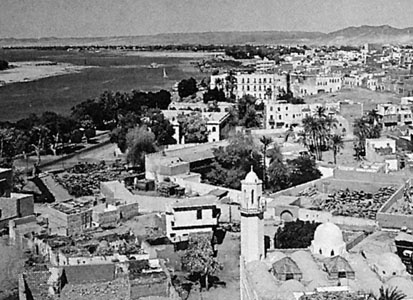Aswān
Egypt
also spelled Assuan, or Assouan, Greek Syene,
 city, capital of Aswān muḥāfaẓah (governorate), Egypt, on the east bank of the Nile just below the First Cataract. It faces the island of Elephantine (modern Jazīrat Aswān), on which stand the ruins of the ancient city of Yeb. Aswān was the southern frontier of pharaonic Egypt. Its local quarries supplied granite for many ancient Egyptian monuments and are still operated. On the Nile's eastern bank was the site of the ancient city of Swen (ancient Egyptian: “the Mart”), whence came the Greek Syene and the Arabic Aswān. Aswān later served as a frontier garrison post for the Romans, Turks, and British.
city, capital of Aswān muḥāfaẓah (governorate), Egypt, on the east bank of the Nile just below the First Cataract. It faces the island of Elephantine (modern Jazīrat Aswān), on which stand the ruins of the ancient city of Yeb. Aswān was the southern frontier of pharaonic Egypt. Its local quarries supplied granite for many ancient Egyptian monuments and are still operated. On the Nile's eastern bank was the site of the ancient city of Swen (ancient Egyptian: “the Mart”), whence came the Greek Syene and the Arabic Aswān. Aswān later served as a frontier garrison post for the Romans, Turks, and British.Modern Aswān is an administrative centre, winter resort, and commercial centre, receiving trade from The Sudan. It is also an industrial centre, with a copper- and steel-producing complex, a chemicals plant producing fertilizer, a cement plant, a sugar refinery, and quarries producing granite and marble. The old Aswān Dam (completed in 1902) rises about 3 miles (5 km) south of the city; the Aswān High Dam (completed in 1970) is about 7 miles (11 km) south of the city. The Higher Industrial Institute is located in Aswān. A school for fisheries training opened in 1980. On Elephantine a museum contains antiquities from the governorate. There are many hotels in the city, which is the southern terminus of the Cairo–Aswān railway. There is also an international airport. Pop. (1996) 219,017.
governorate, Egypt
also spelled Assuan, or Assouan
muḥāfaẓah (governorate), Upper Egypt, embracing the Nile River floodplain and immediately adjacent territories. Long and narrow in shape, it is the most southerly Egyptian governorate along the Nile; its short southern boundary forms part of the international frontier with The Sudan. The sandstone, granite, and diorite hills flanking the Nile are dissected by ancient, long-dried-up streams. At the capital of Aswān and at Wadi Ḥalfā, at the Sudanese frontier, the Nile flows through granite formations that, having eroded more slowly, have produced rapids and islands in the river, called cataracts. These presented obstacles to river traffic and were a factor in the location of the frontier at Aswān in pharaonic Egypt.
Just above the city of Aswān is the old Aswān Dam. Some 4 miles (6 km) farther south is the Aswān High Dam (Aswan High Dam), one of the world's great engineering works, completed in 1970. South of the High Dam for nearly 150 miles (240 km) to the Sudanese border is a hilly, inhospitable desert wilderness without roads or railroads, with the original river valley flooded by Lake Nasser.
Since 1968, when the High Dam became operational, many formerly summer-irrigated lands have been converted to year-round irrigation in Aswān governorate. Sugarcane, lentils, corn (maize), and wheat are grown in the area north of Aswān city. Industry in the governorate is centred on the High Dam and in the towns of Kawm Umbū and Idfū, both of which have sugar refineries. Granite has long been quarried around Aswān city, and marble quarries opened in modern times. Tourism also is important, as the governorate is rich in well-preserved ancient monuments. In the 1960s a massive international scientific effort removed the Egyptian temples threatened by the rising waters of Lake Nasser to higher ground; the most complex efforts involved Abu Simbel and Philae. Area 262 square miles (679 square km). Pop. (2006) 1,184,432.
- Charles Loring Brace
- Charles-Louis de Saulces de Freycinet
- Charles-Louis de Secondat, baron de La Brède et de Montesquieu
- Charles-Louis de Secondat Montesquieu, baron de La Brède et de
- Charles Louis Fefferman
- Charles-Louis Philippe
- Charles-Lucien Bonaparte, Principe Di Canino E Di Musignano
- Charles-Lucien, Principe Di Canino E Di Musignano Bonaparte
- Charles MacArthur
- Charles Macintosh
- Charles Macklin
- Charles Maclaren
- Charles Manning Child
- Charles Manson
- Charles-Marie de La Condamine
- Charles-Marie-René Leconte de Lisle
- Charles-Marie Widor
- Sir Andrew, 1st Baronet Noble
- Sir Andrew Clarke
- Sir Andrew Fielding Huxley
- Sir Andrew Noble, 1st Baronet
- Sir Andrzej Panufnik
- Sir André Previn
- Sir Angus Wilson
- Sir Anthony Caro